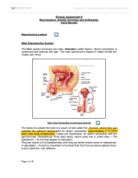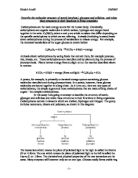Investigating how sugars are metabolised by yeast
Investigating how sugars are metabolised by yeast. Aim The aim of this experiment is to investigate which of the five different forms of sugars namely; glucose, fructose, sucrose, maltose and lactose undergo the most metabolisms by yeast. Variables Independent Variable Type of sugar Controlled Variables Temperature of water Amount of yeast Time of reaction Dependant Variable Amount of Carbon dioxide produced during the metabolic reaction Apparatus List Electronic Stopwatch Thermometer 10cm³ syringe Burette Thin rubber tubing Hot Water bath Stirring rod Clamp Stand Diagram Method * Prewarm Yeast and sugars in water bath at fixed temperature of 50°C. * When reached at required temperature, measure out 6cm³ of yeast, with the help of a syringe, as well as 10cm³ of glucose solution, first. * Pour into a boiling tube and fit with the rubber tubing. * Take the other end of the tubing and place under the upturned burette, which is filled with water in a bowl. * Read and record start volume of water on the burette. * Start the timer as soon as the rubber tubing is placed under the burette. * Time for maximum 10 minutes. * Stop the timer and record the change in volume on burette. * Repeat this exercise 3 times for each sugar for reliability. * Calculate the difference between start and end volume to find out the amount Carbon Dioxide
An investigation on the effect of temperature on beetroot membrane structure.
An investigation on the effect of temperature on beetroot membrane structure Hypothesis: As the temperature increases, the concentrationamount of betalains leaking from beetroot membranes increases. Null hypothesis: Background information: As the temperature increases, the concentration of betalains leaking out from the beetroot membrane will not increase. Introduction: The problem that I will be investigating in the experiment is that if the membrane structure is affected by temperature of different ranges. Beetroot contains red pigments called betalains, and they are located in the cell vacuoles (as water soluble protein complexes). When the cells of the beetroot are cut or heated they release the betalainsreleases red pigments, and this is why red beetroot leave a purple/red stain. (1) The cell membrane is a partially permeable lipid bilayer coated by proteins which comprises the outer layer of a cell (see fig 1). (Fig 1 ref 2) This membrane is a partially permeable membrane. The proteins are embedded inside of the cell membrane. The lipid content of the membrane allows the cell membrane to automatically repair itself when it is torn. The movement of cells can also be described by the fluid mosaic model (see fig 2). (Fig 2 ref 3) The lipid bilayers are fluid and so individual phospholipids diffuse rapidly throughout the two dimensional surface of the
The Role of Carbohydrates in Living Organisms
The Role of Carbohydrates in Living Organisms Carbohydrates are composed of the elements carbon, hydrogen, and oxygen. The general formula is Cx(H2O)y. There are many different types of carbohydrates present in living organisms, each playing an important role in maintaining life of organisms. Monosaccharides are a group of carbohydrates, which include simple sugars such as glucose, fructose and galactose. Monosaccharides are classified according to the number of carbon atoms they possess. Trioses such as glyceraldehyde, and dihydroxyacetone contain three carbon atoms. The phosphorylated form of glyceraldehyde is the first formed sugar in photosynthesis, and may (like dihydroxyacetone) be used as respiratory substrate, or is converted to starch for storage. Both of these trioses are intermediates in glycolysis, where glucose is broken down by enzymes into pyruvic and lactic acid. Pentoses such as ribose an ribulose possess five carbon atoms. Ribose or deoxyribose make up part of nucleotides and as such give structural support to nucleic acids RNA and DNA. Ribose is a constituent of hydrogen carriers such as NAD, NADP and FAD. Further more it is involved in the synthesis of coenzymes and ATP. The third type of monosaccharides is hexoses like glucose and fructose, which possess six carbon atoms. Glucose has a number of significant functions in both plants and animals. Most
Homeostatic Control of Blood Glucose Levels
Adnan Undre Homeostatic Control of Blood Glucose Levels Glucose is an essential substance in the body as it the primary source of energy for all biological functions and is indeed the only form of energy which can be used by the brain and central nervous system. The ideal level of blood glucose is 80 - 90mg of glucose per 100mls of blood. However this level is not static - it oscillates due to changes in the body which are brought about by actions such as eating a meal, exercising, or not eating for long periods. If blood glucose levels drop or rise dramatically there may be serious consequences such as hypo- or hyperglycaemia which can both cause death. Thus it is necessary for blood glucose levels to be regulated and this is achieved through homeostasis. To work effectively homeostasis requires an effective receptor to detect variations from the norm and a negative feedback system where antagonistic processes work to redress any variations as they occur. By examining the mechanisms of the homeostatic control of blood glucose levels it should be possible to explore the consequences of a breakdown of this part of the endocrine system. Essentially, blood glucose levels are controlled by the pancreas. It is in this organ that areas of cells called the Islets of Langerhans exist, which consist of alpha cells and beta cells. These cells monitor blood glucose and secrete the
Comparison of Transport System in Amphibian and Mammalian models
Practical 5 Comparison of Transport System in Amphibian and Mammalian models .0 Introduction Frogs belong to a group of animals called Amphibia that tend to almost always reside in confined habitats near water; making them both terrestrial and water-living animals. They tend to inhibit moist, damp conditions such as swamps and marshes. Frogs have powerful hind limbs adapted for swimming and leaping as their method of locomotion. The webs on the hind feet provide a large surface area for pushing against the water surface. Their eyes have a protective lid and can be withdrawn into the skull while the eardrums are located behind and below the eyes. Frogs have a loose-fitting, thin, moist skin which is supplied with a network of blood vessels. The skin is used for respiration and oxygen is absorbed through its surface and into the blood. The frog's nostrils are specialized to allow respiration while submerged underwater. There are valves that prevent water from entering their nasal cavities. Rats belong to a group of animals called Mammalia that are solely terrestrial. Round circular ears are located on both anterior sides of the rat's head. They have small eyes and the mouth is located below the nose. The rats have a touch sensor system that is known as the whiskers on its nasal region called the vibrissa. As for the neck and body, a rat has a short neck with its body
Reproduction, Gamete formation and fertilisation
Biology Assignment 8 Reproduction, Gamete formation and fertilisation Katie Bennett Reproductive system Male Reproductive System The Male system produces sex cells (Gametes) called Sperm. Sperm production is continuous and reduces with age. The main reproductive organs in males include the Testes and Penis. http://www.drstandley.com/images/male.gif The testes lie outside the body in a pouch of skin called the Scrotum, where they can maintain the optimum temperature for sperm production- approximately 3 0C (50F) lower then body temperature. Testes are responsible for sperm production and the sex-hormone Testosterone. From each testis, sperm pass into a coiled tube - The Epididymis - for the final stages of maturation. They are stored in the Epididymides until they are either broken down or reabsorbed, or ejaculated - forced by movement of seminal fluid from the accessory glands down a duct called the Vas deferens. Inside the Male Scrotum http://www.zianet.com/nlynch/scrotum/testicle1.gif Scrotal Layers http://www.phyto-2000.co.uk/images/reproductive-system2.jpg Each testis is covered by a thin tissue layer, the Tunica vaginalis around which is a layer of connective tissue called Fascia. A Muscle layer called the Dartos muscle relaxes in hot weather to drop the testes away from the body to keep them cool. In cold weather the muscle contracts to draw up the
A Colorimetric Method for the Estimation of Glucose in Solution.
A Colorimetric Method for the Estimation of Glucose in Solution Method A clean pipette was used to transfer 10cm of 10% glucose into a boiling tube. The pipette was then used to transfer 9cm of 10% glucose into a different boiling tube. 1 cm of distilled water was added to give 10cm of 9% glucose. This was repeated to make 10cm of 8%, 7%, 6%, 5%, 4%, 3%, 2%, and 1% glucose solutions (use the table below to help): Concentration of glucose (%) Volume of 10% glucose to transfer (cm ) Volume of distilled water to transfer (cm ) Total volume of solution (cm ) 0 0 0 0 9 9 0 8 8 2 0 7 7 3 0 6 6 4 0 5 5 5 0 4 4 6 0 3 3 7 0 2 2 8 0 9 0 A clean pipette was used to transfer 5 cm of 1M sulphuric acid into each solution. A clean pipette and pipette filler was used to transfer 2cm of potassium permanganate solution into each boiling tube. A stopwatch was started the exact moment the potassium permanganate was added to the acidified glucose solutions. A time was recorded, in seconds for the complete decolourisation of the potassium permanganate solutions. Results Concentration of glucose (%) Start time (seconds) Finish time (seconds) Elapsed time (seconds) 0 90 562 472 9 80 578 498 8 70 590 520 7 60 605 545 6 50 614 564 5 40 629 589 4 30 635 605 3 20 963 943 2 0 787 777 0 2486 2486 Results of
The Effect Of Temperature On The Permeability Of The Cell Membrane
"The Effect Of Temperature On The Permeability Of The Cell Membrane" Aim: My aim of this experiment is to investigate whether changing the temperature (independent variable) of the water around a disk of a beetroot will affect the permeability of a beetroot, by measuring the release of pigment (dependant variable) into water using a digital colorimeter. The colorimeter will be used to measure the light absorbency of anthocyanin (the pigment found in the cell membrane of the beetroot) this can help us work out how much diffusion takes place at different temperatures such as 0,20,40, 60 and 80 degrees Celsius. Introduction I will be conducting an experiment to find out what effect different temperatures has on the permeability of the Beetroot's cell membrane; the temperatures that I will be testing on the beetroot is 0, 20, 40 and 60 degrees Celsius. Background Knowledge Most people think that Beetroot cells are colored red because they contain a red dye called anthocyanin, But in fact they are colored red caused by two distinct pigments, there is a yellow one known as a betaxanthin and a purple pigment known as betacyanin and are together they are referred to as betalins. In beetroot cells the red anthocyanin pigment occurs in the vacuoles. A membrane called the tonoplast surrounds each vacuole. The cytoplasm and vacuole is surrounded by the plasma membrane. The

























